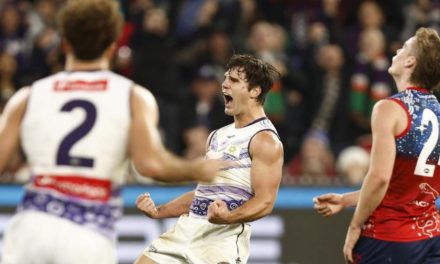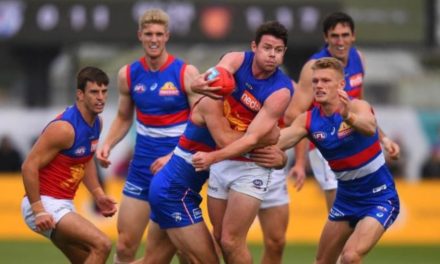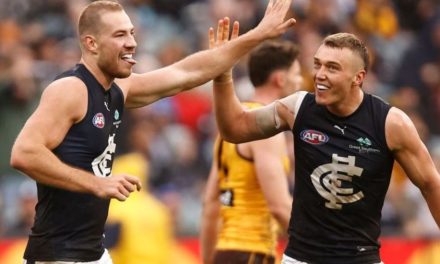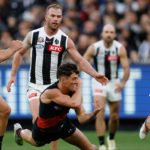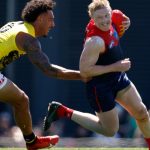Rookies Braeden Campbell (left) and Errol Gulden have made a huge splash this season. Photo: SYDNEY SWANS
Sydney had a very good reason for its continual “topping up” of senior talent when the Swans were coached by Paul Roos.
As Roos himself noted, so precarious a place did the club occupy in the Sydney sporting landscape that it could never again afford to return to the dark days of 1992-93, when during a string of 35 games, it won just one.
That meant the nuclear option of torpedoing a playing list and building from the ground up via the draft was never on. Fortunately, under Roos, neither was that ever a serious necessity ignored.
Almost all of Sydney’s experienced imports inevitably ended up playing key roles in the Swans’ continued success.
Former Lion Craig Bolton, former Pie Nick Davis and ex-Melbourne ruckman Darren Jolly were pivotal to the Swans’ famous 72-year drought-breaking premiership under Roos in 2005.
Under Roos, Sydney then picked up former Essendon player Ted Richards, and a few seasons later, Magpie Rhyce Shaw, Hawthorn pair Josh Kennedy and Ben McGlynn, and Geelong ruckman Shane Mumford.
Four of those five played in the Swans’ next flag in 2012 under John Longmire. It would have been all five had McGlynn not been injured in the finals that year.
Nearly a decade later, though, the landscape has shifted significantly. And, while Longmire is still in the coaches’ box, from a big picture point of view, very positively.
Just two games into 2021, the new-look Swans are looking like one of the potential “bolters” of the season, two wins from two, having knocked over the Lions in Brisbane in their first outing then easily accounting for Adelaide at the SCG.
Full of youthful dash and spark, they are a Sydney line-up which couldn’t be more at odds with the one-dimensional cliche of the Swans as a dour, defensive-minded and contest-driven team whose primary aim under both Roos and Longmire was always about shutting down the opposition, scrapping away and striking on the rebound.
In their two wins, the Swans have racked up 37 goals in two games to sit No.1 on the table for points scored, registering their two highest scores for their past 50 outings.
They beat Brisbane at the Gabba fielding three debutants and six players with 10 or fewer AFL games against their names. The likes of Errol Gulden, Logan McDonald and Braeden Campbell have been instant hits.
PLEASE HELP US CONTINUE TO THRIVE BY BECOMING AN OFFICIAL FOOTYOLOGY PATRON. JUST CLICK THIS LINK.
But they’ve merely complemented the kids Longmire has already spent time blooding, players such as Jordan Dawson, James Rowbottom, Justin McInerney, Hayden McLean, James Bell, Dylan Stephens and Sam Wicks.
Callum Mills, Rowbottom, Dawson and Ollie Florent filled nearly half of Sydney’s best-and-fairest top 10 last year. None of them are older than 23.
But the older hands are still producing. The top three in that same best-and-fairest were Jake Lloyd, Luke Parker and Tom Papley. That old warhorse Kennedy finished eighth.
That’s symbolic of where Sydney has been for a number of years now under Longmire. Still attempting to contend for higher honours. But not at the expense of developing for the future.
And it continues to work. Last year was the first time the Swans had missed consecutive finals series since 1994-95. And it already appears pretty clear that is a sequence which won’t be continuing much longer, if at all.
Sydney under Roos was a top-up team which always remained competitive. Under Longmire, with the obvious exception of Lance Franklin (and the ill-fated luring of Kurt Tippett) it has shown far more focus on development from within.
The significance of that goes beyond the success the strategy has delivered, Sydney winning a premiership, playing in three grand finals and being part of eight finals series during Longmire’s 10 full seasons in charge.
It’s helped rewrite the rule book on AFL list management. Where once the popular belief was that clubs had to be either contending or rebuilding, the Swans, along with Geelong and Hawthorn, have shown it’s possible to do both.
Perhaps even more importantly for Sydney, more than two decades now of sustained competitiveness have given Longmire some wriggle room his predecessor in the coaches’ box never had.
You can argue the toss over just how dramatic a rebuild Sydney is now undertaking. But what’s been notable during the last couple of finals-less seasons is the sense of relative calm in the club’s supporter base, a supposedly fickle Sydney sporting market and even the notoriously “antsy” Sydney sporting media.
Their club has done it so well for so long now they have plenty of confidence that even if their team is indeed down, it won’t remain down for long.
And while yes, it’s only two games into a new season, it already looks pretty clear that confidence hasn’t been misplaced.
*This article first appeared at STATS INSIDER.


